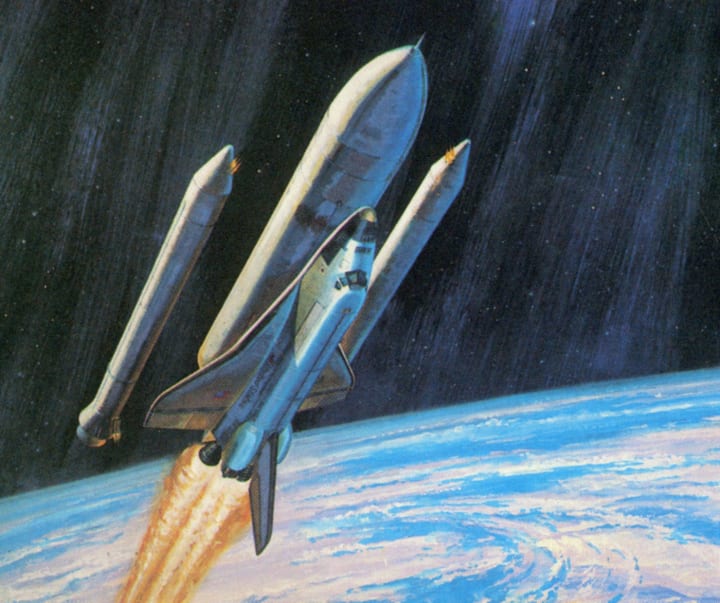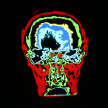History of Flight
From the Wright Brothers to the Space Shuttle, the history of flight is taking off.

In 1903, man realized a primal dream—to fly. The Wright brothers's hometown paper was one of the few to note the epochal achievement. Today, we have gone above and beyond the beginnings of flight, even entering space. Today's flight technologies have a long and intriguing history of development and dedication to the dream to take to the skies.
Τhe Decisive Μoment

"Human flight is possible and practicable," declared 33-year-old Wilbur Wright in May of 1899, despite centuries of evidence to the contrary. Just after 10:30 AM On December 17, 1903, the 12-horsepower wood-and-cloth Wright airplane began its 40 foot takeoff run down a track of two-by-fours on the lonely sands of North Carolina's Outer Banks. With younger brother Orville piloting, the plane climbed willingly into a helping headwind. The first of the day's four flights lasted 12 seconds and covered 120 feet. In only four and a half years, the Wrights had correctly perceived the fundamental problems of flight, solved them, and produced a series of increasingly successful flying machines. Their 1902 glider could be perfectly controlled through linked wing and rudder adjustments, lacking only an engine and propeller to achieve practical, powered flight.
A replica of the 1903 Wright glider was built for ITT's television drama celebrating the 75th anniversary of flight. The plane's wing was clamped to the bench in the foreground before the flight began, the battery for starting the engine lies in the sand next to a can containing nails and a hammer for last-minute repairs. Wilbur stood by as Orville flew.
Purest Flight

The Wrights understood from the start: "It is possible to fly without motors, but not without knowledge and skill." The very best of their predecessors had failed—some fatally, like the German gliding pioneer Otto Lilienthal—not because they lacked engines and propellers but because they could not control the attitude of their craft in the air. The Wrights reinvented the avian solution, twisting their wings in flight to maintain balance and to make banked turns, using the rudder to equalize drag. Today's ethereal sailplanes and elemental hang gliders are the true descendants of Lilienthal and the Wrights. After crashing, out of control, in one of his bird-wing gliders in 1896, Otto Lilienthal's dying words were: "Sacrifices must be made."
The Military Motive

Almost from the beginning of manned flight, military necessity has been the mother of aeronautical invention. For urgent killing purposes, ingenious engineers devised airborne armaments—from the first, hand-dropped bombs and propeller-synchronized machine guns to today's air-to-air, heatseeking rockets—and successive generations of planes that could fly higher, lower, faster, or farther than the enemy, carry bigger payloads, take off straight up, stand still in the air, or fly tight arabesques. A 1909 Wright two-seater was the first military airplane, sold to the US Army Signal Corps for $30,000; The Navy ordered two floatplanes from Wright rival Glenn Curtiss in 1911. By 1914, the start of World War I, Germany could put about 1200 combat planes in the air, France and Britain about 1000. The race for superior airpower was off and flying. Wrote Orville Wright in 1917: "We thought that we were introducing into the world an invention that would make future wars practically impossible." He lived to see World War II.
Human Cargo

In 1911, flying in the passenger seat of even the latest, safest biplane was hardly routine. For the general public, flying was still a spectator sport. As late as 1919, the world's fledgling airlines carried a total of some 5,000 paying passengers. However, in 1928, the year after Lindbergh's epic Solo, US airlines alone doubled their mileage and quadrupled their passenger loads. Worldwide, there were some half million paying airplane passengers in 1929. In 1977, the World's scheduled air carriers sold over 600 million tickets to a public that takes flight for granted. Today's BritishFrench Concorde carries high-paying passengers from New York to Paris at Mach 2—1400 mph—in three hours and 20 minutes. Fifty years ago, Lindbergh made the same trip in 33 hours, 30 minutes.
Trial and Error

Even 75 years after the first plane was built, with the best tools of science, aircraft designers still couldn't predict exactly how a new plane was going to fly until they build one and fly it, first as a model, finally as a full-scale prototype. The Wrights were the first aeronautical scientists, as well as the first men to fly, systematically testing model wings in a wind tunnel to establish the first accurate coefficients of lift and drag, then trying their planes as kites in controlled experiments before piloting them in free flight. Today, aeronautical R&D has become so expensive that only big companies and rich governments can afford it. Intrepid individualism persists, however, in a few maverick inventors who out-innovate the giants with designs for flight as radical and elegant as Burt Rutan's 580-pound, 180-mph, all-fiberglass Vari-Eze. Vari-Eze was first plane to fly with upturned winglets for high lift. Its speed officially described only as "2000 mph plus," the YF-12 is used for high speed research and spying.
Reach for the Stars

Even as the Wrights were conquering the air in 1903, a self-taught, visionary Russian, Konstantin Tsiolkovsky, was writing equations for rocket-powered flight to the far reaches of the solar system. Today's rockets can boost men and materials into space, but the real key to practical space flight is the Shuttle, which can ride a rocket into space, perform a variety of vital missions, then glide safely back to earth, to fly again. The first rocket launch of NASA's Space Shuttle took place in 1981.
Recommended Reading
We have documented developments made during the first 75 years of flight. Explore these years in greater depth and continue soaring through the history of flight and aviation with Flight: The Evolution of Aviation by Stephen Woolford.
There was less than a century between the first flight of the Wright Brothers and the rocket launch to the moon. Flight: The Evolution of Aviation by Stephen Woolford takes readers through the evolution of aviation, from the early pioneers to the complex technology of today's military jets.
About the Creator
Futurism Staff
A team of space cadets making the most out of their time trapped on Earth. Help.






Comments
There are no comments for this story
Be the first to respond and start the conversation.